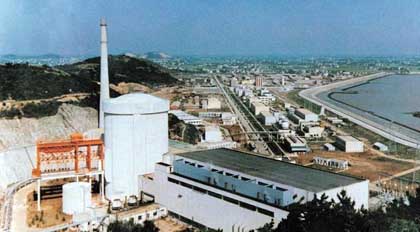The first phase of Qinshan Nuclear Power Plant (Qinshan-I), China's first nuclear plant, will be able to double its operational life through a cutting-edge plant life management (PLiM) mechanism, the plant's top engineer has said.
The first phase of Nuclear Power Plant (Qinshan-I), China's first nuclear plant, is 16 years old.
"Qinshan-I is 16 years old. We're aware of the issue of life management and we have started introducing the PliM method," Ma Huiming, chief engineer of the Qinshan Nuclear Power Company, told China Daily on the sidelines of an International Atomic Energy Agency (IAEA) symposium on PliM which concluded yesterday.
"With effective plant life management methods, Qinshan-I will probably be able to run another 20-40 years after its 30-year designed life."
"It will save the cost of a new nuke plant if we have Qinshan-I run for another 40 years safely, not to mention the cost for disposing of the expired reactor."
The PliM methodology can help optimize repair, replacement or modification of systems, structures and components of reactors, while ensuring a high level of safety.
Yuri Sokolov, IAEA's deputy director-general also expressed optimism for the mechanism.
"This (PliM) is especially important as the world's fleet of 439 nuclear power plants has been operating, on average, for more than 20 years."
Qinshan-I teams are working with leading academies to conduct regular inspections and assessments of the key equipment in the plant, a core part of the PLiM methodology.
Strict checks on shell-like containment facilities designed to prevent radiation leakage into the atmosphere, are conducted in line with PliM standards.
"Non-destructive testing methods such as ultrasonic testing have been introduced for examination," Ma said.
"As the Qinshan-I is the first nuke power plant in China, nuclear safety is our country's top priority. Fortunately there have been no safety-related aging problems occur."
The Shanghai Nuclear Engineering Research and Design Institute (SNERDI) and the Research Institute of Nuclear Power Operation of Wuhan in Central China, provide PliM technical support for Qinshan-I.
Dou Yikang, a senior engineer with the Shanghai nuclear institute, which designed Qinshan-I, agreed with Ma's expectations for the plant's life, but added it had to undergo sophisticated research and verification processes.
"Technical feasibilities aside, we have to do a series of complex assessments to prove that it will do no harm to the environment and residents," Dou said.
The 300-megawatt Qinshan-I, located in the eastern province of Zhejiang, started operation in 1991. It cost 1.2 billion yuan (US$159.76 million) to build the first nuke plant in China at that time.
But it would cost about US$450 million to build a similar plant today, based on current construction costs, Dou said.
(China Daily October 19, 2007)






